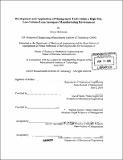Development and application of management tools within a high-mix, low-volume lean aerospace manufacturing environment
Author(s)
McKenney, Kevin (Kevin Bryan), 1977-
DownloadFull printable version (13.59Mb)
Alternative title
Management tools within a high-mix, low-volume lean aerospace manufacturing environment
Other Contributors
Leaders for Manufacturing Program.
Advisor
David Hardt and Stephen Graves.
Terms of use
Metadata
Show full item recordAbstract
The design and implementation of a lean production system is a complex task requiring an intimate understanding of the fundamental lean principles. Much of the published lean literature is written at a high level of abstraction and contains very basic examples. When lean tools are applied blindly to complex, highly constrained systems, lean implementation becomes challenging and often ineffective. This thesis develops a set of management tools that emphasize the fundamental lean principles and the importance of an overarching value stream level management perspective in an effort to drive appropriate system design decisions and management behavior in such an environment. This thesis proposes the design of a high-mix, low-volume (HMLV) lean production system for implementation at Hamilton Sundstrand, a global supplier of technologically advanced aerospace and industrial products. The system establishes a series of mixed model flow lines based upon the principles of cellular manufacturing. The flow lines operate in a true pull fashion with an optimally sized finished goods supermarket and a strategic, continuous review incoming material ordering policy. In addition, a capacity planning tool, a long term resource cross-training planning tool, and a series of leading metrics and management levers are developed in order to help steer management decisions.
Description
Thesis (M.B.A.)--Massachusetts Institute of Technology, Sloan School of Management; and, (S.M.)--Massachusetts Institute of Technology, Dept. of Mechanical Engineering; in conjunction with the Leaders for Manufacturing Program at MIT, 2005. Includes bibliographical references (p. 104-105).
Date issued
2005Department
Leaders for Manufacturing Program at MIT; Massachusetts Institute of Technology. Department of Mechanical Engineering; Sloan School of ManagementPublisher
Massachusetts Institute of Technology
Keywords
Mechanical Engineering., Sloan School of Management., Leaders for Manufacturing Program.